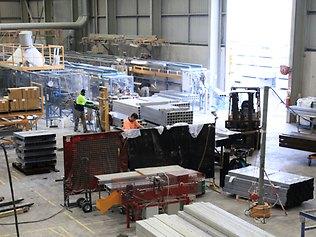Rush of leasing deals on horizon in Brisbane
THE level of available industrial space in Brisbane continues to bump along at historic lows.

AS the level of available industrial space in Brisbane continues to bump along at historic lows, there is mounting evidence that a glut of lease expiries will spark a rush of transactions.
Industrial insiders claim it's one of the toughest markets in years, with a slowing down of deals and a lack of large office/warehouse development.
This has affected vacancy with Knight Frank's latest industrial analysis reporting only 170,398sq m of available space across 35 prime and secondary 3000sq m plus industrial properties.
That was 6505sq m lower than the April figure, and 50 per cent below the average of 337,773sq m, recorded since the start of the series in early 2007.
However, a Jones Lang LaSalle survey has forecast the market is about to enter a period of large lease expiries, which are tipped to create much needed movement.
The study showed the bulk of large industrial leases were negotiated between 2004 and 2006. With the average lease term of seven to nine years, many tenants are looking at lease renewals, reassessment or relocations.
JLL's Gary Hyland said it was time for tenants and landowners to review their options.
"We are seeing more inquiries and a flow-on effect from the mining industry,'' he said.
"This will mean renegotiations, market movement and potentially the beginning of speculative development, to accommodate this increase in demand. With land opportunities limited in the traditional industrial suburbs, occupiers will have to consider emerging industrial precincts.''
JLL believes that the suburbs located within the western corridor will be the main beneficiary from the increased activity.
"The recent upgrades to critical infrastructure including the Centenary Highway and Ipswich Motorway, has opened up the likes of Swanbank and Redbank as employment hubs,'' Mr Hyland said.
"Both areas are able to accommodate occupiers seeking land holdings 5ha plus with supporting infrastructure.''
Knight Frank director - research (Qld) Jennelle Wilson said in the past quarter the level of prime available space increased by 19,642sq m to 68,134sq m.
"This is due to a combination of factors including tenant relocation, consolidation from tenants of multiple holdings and also sub-lease space from tenants seeking to exit the Brisbane market,'' she said.
"Therefore more good quality buildings have become available.
"Despite a number of speculative developments being progressed by developers, none have officially commenced construction as yet, but we remain of the expectation that this will occur shortly.''
Ms Wilson said the level of available space was expected to gradually increase off the record lows over the next year
"The sustained low levels of available space, particularly in the prime market over the past 12 months has now begun to translate into rental growth, with the Brisbane average prime rents recording an increase of 3.5 per cent over the year to April 2012,'' she said.
"For tenants seeking prime accommodation within a relatively short time frame, the choice remains limited and this is expected to continue to support both modest rental growth and also speculative development activity.''
